Zero-Shot Generative AI for Rotating Machinery Fault Diagnosis: Synthesizing Highly Realistic Training Data via Cycle-Consistent Adversarial Networks
Abstract
:1. Introduction
2. Generative AI and Machine Fault Diagnosis
3. Generating Synthetic Bearing Fault Data via cycleGAN
3.1. Experimental Activity
3.2. Simulating Bearing Vibration Signal
3.3. Data Pre-Processing and CycleGAN Training
- simulating the accelerometer signal;
- pre-processing the signal through normalization, filtering and envelope extraction;
- applying the continuous wavelet transform and generating 256 × 256 images by squaring the CWT coefficients;
- utilizing the images as input for the cycleGAN model previously trained to transform images of simulated signals into their corresponding real counterparts. The resulting output of the cycleGAN model is an image that is a surrogate for a real image from experimental activity.
3.4. Validation of the CycleGAN Generative Model
4. Results and Discussion
5. Conclusions
- cycleGANs were found to be very efficient architectures for producing synthetic data in the form of CWT images, which may be utilized to augment or substitute real bearing fault data;
- the synthetic data generated by cycleGANs exhibiedt a higher degree of resemblance to real data when compared to the outcomes obtained from a simulation model. This assertion holds true for both the specific machine operating conditions that the generative algorithm was explicitly trained on, as well as for different conditions;
- the proposed methodology was able to generate data for working conditions that could be entirely lacking in the experimental activity. It is claimed that generative zero-shot capabilities arise also as a result of the cycle consistency inherent in the generative model;
- the synthetic data generated by the model were found to be effective for training diagnostic algorithms, which exhibited very high accuracy when evaluated using real data collected from the rotating machinery.
Author Contributions
Funding
Institutional Review Board Statement
Informed Consent Statement
Data Availability Statement
Conflicts of Interest
Appendix A
| Structure | Block | Layer | Filter Size | Stride/ Padding | Channels |
|---|---|---|---|---|---|
| Image input layer 256 × 256 × 3 | |||||
| Encoder | 1 | Convolution | 4 × 4 | 2/1 | 64 |
| Batch norm | - | - | - | ||
| ReLU | - | - | - | ||
| 2 | Convolution | 4 × 4 | 2/1 | 128 | |
| Batch norm | - | - | - | ||
| ReLU | - | - | - | ||
| 3 | Convolution | 4 × 4 | 2/1 | 256 | |
| Batch norm | - | - | - | ||
| ReLU | - | - | - | ||
| Convolution | 3 × 3 | 1/1 | 256 | ||
| Residuals | 1–6 | Batch norm | - | - | - |
| ReLU | - | - | - | ||
| Decoder | 1–2 | Transposed convolution | 4 × 4 | 2/ | 128 |
| Barch norm | - | - | - | ||
| ReLU | - | - | - | ||
| 3 | Transposed convolution | 4 × 4 | 2/ | 3 | |
| Tanh | - | - | - | ||
| Layer | Filter Size | Stride/ Padding | Channels |
|---|---|---|---|
| Image input layer 256 × 256 × 3 | |||
| Convolution | 4 × 4 | 2/1 | 80 |
| ReLU | - | - | - |
| Convolution | 4 × 4 | 2/1 | 160 |
| Batch norm | - | - | - |
| ReLU | - | - | - |
| Convolution | 4 × 4 | 2/1 | 320 |
| Batch norm | - | - | - |
| ReLU | - | - | - |
| Convolution | 1 × 1 | 1/0 | 1 |
References
- Lei, Y.; Yang, B.; Jiang, X.; Jia, F.; Li, N.; Nandi, A.K. Applications of Machine Learning to Machine Fault Diagnosis: A Review and Roadmap. Mech. Syst. Signal Process. 2020, 138, 106587. [Google Scholar] [CrossRef]
- Lei, Y.; Li, N.; Guo, L.; Li, N.; Yan, T.; Lin, J. Machinery Health Prognostics: A Systematic Review from Data Acquisition to RUL Prediction. Mech. Syst. Signal Process. 2018, 104, 799–834. [Google Scholar] [CrossRef]
- Li, C.; Zhang, S.; Qin, Y.; Estupinan, E. A Systematic Review of Deep Transfer Learning for Machinery Fault Diagnosis. Neurocomputing 2020, 407, 121–135. [Google Scholar] [CrossRef]
- Liu, R.; Yang, B.; Zio, E.; Chen, X. Artificial Intelligence for Fault Diagnosis of Rotating Machinery: A Review. Mech. Syst. Signal Process. 2018, 108, 33–47. [Google Scholar] [CrossRef]
- Mohanty, A.R. Machinery Condition Monitoring: Principles and Practices; CRC Press: Boca Raton, FL, USA, 2014; ISBN 978-1-4665-9305-3. [Google Scholar]
- Alabsi, M.; Liao, Y.; Nabulsi, A.A. Bearing Fault Diagnosis Using Deep Learning Techniques Coupled with Handcrafted Feature Extraction: A Comparative Study. JVC J. Vib. Control. 2021, 27, 404–414. [Google Scholar] [CrossRef]
- Abbasion, S.; Rafsanjani, A.; Farshidianfar, A.; Irani, N. Rolling Element Bearings Multi-Fault Classification Based on the Wavelet Denoising and Support Vector Machine. Mech. Syst. Signal Process. 2007, 21, 2933–2945. [Google Scholar] [CrossRef]
- Brusa, E.; Delprete, C.; Di Maggio, L.G. Eigen-Spectrograms: An Interpretable Feature Space for Bearing Fault Diagnosis Based on Artificial Intelligence and Image Processing. Mech. Adv. Mater. Struct. 2022, 30, 4639–4651. [Google Scholar] [CrossRef]
- Delprete, C.; Brusa, E.; Rosso, C.; Bruzzone, F. Bearing Health Monitoring Based on the Orthogonal Empirical Mode Decomposition. Shock. Vib. 2020, 2020, 8761278. [Google Scholar] [CrossRef]
- Brusa, E.; Bruzzone, F.; Delprete, C.; Di Maggio, L.G.; Rosso, C. Health Indicators Construction for Damage Level Assessment in Bearing Diagnostics: A Proposal of an Energetic Approach Based on Envelope Analysis. Appl. Sci. 2020, 10, 8131. [Google Scholar] [CrossRef]
- Genta, G. Dynamics of Rotating Systems; Springer Science & Business Media: Berlin, Germany, 2007; ISBN 978-0-387-28687-7. [Google Scholar]
- Randall, R.B. Vibration-Based Condition Monitoring: Industrial, Aerospace and Automotive Applications; John Wiley & Sons: Hoboken, NJ, USA, 2011; ISBN 978-0-470-74785-8. [Google Scholar]
- Randall, R.B.; Antoni, J. Rolling Element Bearing Diagnostics—A Tutorial. Mech. Syst. Signal Process. 2011, 25, 485–520. [Google Scholar] [CrossRef]
- Brusa, E. Design of a Kinematic Vibration Energy Harvester for a Smart Bearing with Piezoelectric/Magnetic Coupling. Mech. Adv. Mater. Struct. 2020, 27, 1322–1330. [Google Scholar] [CrossRef]
- Baccarini, L.M.R.; Rocha e Silva, V.V.; de Menezes, B.R.; Caminhas, W.M. SVM Practical Industrial Application for Mechanical Faults Diagnostic. Expert Syst. Appl. 2011, 38, 6980–6984. [Google Scholar] [CrossRef]
- Cortes, C.; Vapnik, V. Support-Vector Networks. Mach. Learn. 1995, 20, 273–297. [Google Scholar] [CrossRef]
- Widodo, A.; Yang, B.-S. Support Vector Machine in Machine Condition Monitoring and Fault Diagnosis. Mech. Syst. Signal Process. 2007, 21, 2560–2574. [Google Scholar] [CrossRef]
- Cover, T.; Hart, P. Nearest Neighbor Pattern Classification. IEEE Trans. Inf. Theory 1967, 13, 21–27. [Google Scholar] [CrossRef]
- Lei, Y.; Zuo, M.J. Gear Crack Level Identification Based on Weighted K Nearest Neighbor Classification Algorithm. Mech. Syst. Signal Process. 2009, 23, 1535–1547. [Google Scholar] [CrossRef]
- Moosavian, A.; Ahmadi, H.; Tabatabaeefar, A.; Khazaee, M. Comparison of Two Classifiers; K-Nearest Neighbor and Artificial Neural Network, for Fault Diagnosis on a Main Engine Journal-Bearing. Shock. Vib. 2013, 20, 263–272. [Google Scholar] [CrossRef]
- Zhao, R.; Yan, R.; Chen, Z.; Mao, K.; Wang, P.; Gao, R.X. Deep Learning and Its Applications to Machine Health Monitoring. Mech. Syst. Signal Process. 2019, 115, 213–237. [Google Scholar] [CrossRef]
- Duan, L.; Xie, M.; Wang, J.; Bai, T. Deep Learning Enabled Intelligent Fault Diagnosis: Overview and Applications. JIFS 2018, 35, 5771–5784. [Google Scholar] [CrossRef]
- Wen, L.; Li, X.; Gao, L.; Zhang, Y. A New Convolutional Neural Network-Based Data-Driven Fault Diagnosis Method. IEEE Trans. Ind. Electron. 2018, 65, 5990–5998. [Google Scholar] [CrossRef]
- Grezmak, J.; Zhang, J.; Wang, P.; Loparo, K.A.; Gao, R.X. Interpretable Convolutional Neural Network Through Layer-Wise Relevance Propagation for Machine Fault Diagnosis. IEEE Sens. J. 2020, 20, 3172–3181. [Google Scholar] [CrossRef]
- Duan, A.; Guo, L.; Gao, H.; Wu, X.; Dong, X. Deep Focus Parallel Convolutional Neural Network for Imbalanced Classification of Machinery Fault Diagnostics. IEEE Trans. Instrum. Meas. 2020, 69, 8680–8689. [Google Scholar] [CrossRef]
- Li, X.; Li, J.; Qu, Y.; He, D. Gear Pitting Fault Diagnosis Using Integrated CNN and GRU Network with Both Vibration and Acoustic Emission Signals. Appl. Sci. 2019, 9, 768. [Google Scholar] [CrossRef]
- Xiao, Q.; Li, S.; Zhou, L.; Shi, W. Improved Variational Mode Decomposition and CNN for Intelligent Rotating Machinery Fault Diagnosis. Entropy 2022, 24, 908. [Google Scholar] [CrossRef] [PubMed]
- Zheng, X.; Wu, J.; Ye, Z. An End-To-End CNN-BiLSTM Attention Model for Gearbox Fault Diagnosis. In Proceedings of the 2020 IEEE International Conference on Progress in Informatics and Computing (PIC), Shanghai, China, 18 December 2020; IEEE: Piscataway, NJ, USA, 2020. [Google Scholar]
- Shao, S.; McAleer, S.; Yan, R.; Baldi, P. Highly Accurate Machine Fault Diagnosis Using Deep Transfer Learning. IEEE Trans. Ind. Inform. 2019, 15, 2446–2455. [Google Scholar] [CrossRef]
- Alzubaidi, L.; Zhang, J.; Humaidi, A.J.; Al-Dujaili, A.; Duan, Y.; Al-Shamma, O.; Santamaría, J.; Fadhel, M.A.; Al-Amidie, M.; Farhan, L. Review of Deep Learning: Concepts, CNN Architectures, Challenges, Applications, Future Directions. J. Big Data 2021, 8, 53. [Google Scholar] [CrossRef]
- Brunton, S.L.; Kutz, J.N. Data Driven Science and Engineering: Machine Learning, Dynamical Systems, and Control; Cambridge University Press: Cambridge, UK, 2019. [Google Scholar]
- CWRU Bearing Data Center. Available online: https://engineering.case.edu/bearingdatacenter (accessed on 3 August 2020).
- Hendriks, J.; Dumond, P.; Knox, D.A. Towards Better Benchmarking Using the CWRU Bearing Fault Dataset. Mech. Syst. Signal Process. 2022, 169, 108732. [Google Scholar] [CrossRef]
- Smith, W.A.; Randall, R.B. Rolling Element Bearing Diagnostics Using the Case Western Reserve University Data: A Benchmark Study. Mech. Syst. Signal Process. 2015, 64–65, 100–131. [Google Scholar] [CrossRef]
- Nectoux, P.; Gouriveau, R.; Medjaher, K.; Ramasso, E.; Chebel-morello, B.; Zerhouni, N.; Varnier, C. PRONOSTIA: An Experimental Platform for Bearings Accelerated Degradation Tests. In Proceedings of the IEEE International Conference on Prognostics and Health Management, Denver, CO, USA, 18–21 June 2012. [Google Scholar]
- Lee, J.; Qiu, H.; Yu, G.; Lin, J. Rexnord Technical Services: Bearing Data Set; IMS, University of Cincinnati, NASA Ames Prognostics Data Repository: Moffett Field, CA, USA, 2007. [Google Scholar]
- Daga, A.P.; Fasana, A.; Marchesiello, S.; Garibaldi, L. The Politecnico Di Torino Rolling Bearing Test Rig: Description and Analysis of Open Access Data. Mech. Syst. Signal Process. 2019, 120, 252–273. [Google Scholar] [CrossRef]
- Deng, J.; Dong, W.; Socher, R.; Li, L.-J.; Li, K.; Li, F. ImageNet: A Large-Scale Hierarchical Image Database. In Proceedings of the 2009 IEEE Conference on Computer Vision and Pattern Recognition, Miami, FL, USA, 20–25 June 2009; pp. 248–255. [Google Scholar] [CrossRef]
- Gemmeke, J.F.; Ellis, D.P.W.; Freedman, D.; Jansen, A.; Lawrence, W.; Moore, R.C.; Plakal, M.; Ritter, M. Audio Set: An Ontology and Human-Labeled Dataset for Audio Events. In Proceedings of the IEEE International Conference on Acoustics, Speech and Signal Processing (ICASSP), New Orleans, LA, USA, 5–9 March 2017; pp. 776–780. [Google Scholar] [CrossRef]
- Devlin, J.; Chang, M.-W.; Lee, K.; Toutanova, K. BERT: Pre-Training of Deep Bidirectional Transformers for Language Understanding. arXiv 2018, arXiv:1810.04805. [Google Scholar] [CrossRef]
- Gozalo-Brizuela, R.; Garrido-Merchan, E.C. ChatGPT Is Not All You Need. A State of the Art Review of Large Generative AI Models. arXiv 2023, arXiv:2301.04655. [Google Scholar] [CrossRef]
- Bommasani, R.; Hudson, D.A.; Adeli, E.; Altman, R.; Arora, S.; von Arx, S.; Bernstein, M.S.; Bohg, J.; Bosselut, A.; Brunskill, E.; et al. On the Opportunities and Risks of Foundation Models. arXiv 2021, arXiv:2108.07258. [Google Scholar]
- Pan, S.J.; Yang, Q. A Survey on Transfer Learning. IEEE Trans. Knowl. Data Eng. 2010, 22, 1345–1359. [Google Scholar] [CrossRef]
- Hasan, M.J.; Sohaib, M.; Kim, J.-M. A Multitask-Aided Transfer Learning-Based Diagnostic Framework for Bearings under Inconsistent Working Conditions. Sensors 2020, 20, 7205. [Google Scholar] [CrossRef] [PubMed]
- Wang, Q.; Michau, G.; Fink, O. Domain Adaptive Transfer Learning for Fault Diagnosis. In Proceedings of the 2019 Prognostics and System Health Management Conference (PHM-Paris), Paris, France, 2–5 May 2019; IEEE: Piscataway, NJ, USA, 2019. [Google Scholar]
- Cao, N.; Jiang, Z.; Gao, J.; Cui, B. Bearing State Recognition Method Based on Transfer Learning under Different Working Conditions. Sensors 2019, 20, 234. [Google Scholar] [CrossRef]
- Pacheco, F.; Drimus, A.; Duggen, L.; Cerrada, M.; Cabrera, D.; Sanchez, R.-V. Deep Ensemble-Based Classifier for Transfer Learning in Rotating Machinery Fault Diagnosis. IEEE Access 2022, 10, 29778–29787. [Google Scholar] [CrossRef]
- Guo, L.; Lei, Y.; Xing, S.; Yan, T.; Li, N. Deep Convolutional Transfer Learning Network: A New Method for Intelligent Fault Diagnosis of Machines with Unlabeled Data. IEEE Trans. Ind. Electron. 2019, 66, 7316–7325. [Google Scholar] [CrossRef]
- Brusa, E.; Delprete, C.; Di Maggio, L.G. Deep Transfer Learning for Machine Diagnosis: From Sound and Music Recognition to Bearing Fault Detection. Appl. Sci. 2021, 11, 11663. [Google Scholar] [CrossRef]
- Di Maggio, L.G. Intelligent Fault Diagnosis of Industrial Bearings Using Transfer Learning and CNNs Pre-Trained for Audio Classification. Sensors 2022, 23, 211. [Google Scholar] [CrossRef]
- Creswell, A.; White, T.; Dumoulin, V.; Arulkumaran, K.; Sengupta, B.; Bharath, A.A. Generative Adversarial Networks: An Overview. IEEE Signal Process. Mag. 2018, 35, 53–65. [Google Scholar] [CrossRef]
- Goodfellow, I.; Pouget-Abadie, J.; Mirza, M.; Xu, B.; Warde-Farley, D.; Ozair, S.; Courville, A.; Bengio, Y. Generative Adversarial Nets. In Proceedings of the 27th International Conference on Neural Information Processing Systems, Cambridge, MA, USA, 8–13 December 2014; MIT Press: Cambridge, MA, USA, 2014; Volume 2, pp. 2672–2680. [Google Scholar]
- Goodfellow, I.; Bengio, Y.; Courville, A. Deep Learning; Adaptive Computation and Machine Learning; The MIT Press: Cambridge, MA, USA, 2016; ISBN 978-0-262-03561-3. [Google Scholar]
- Guo, Q.; Li, Y.; Liu, Y.; Gao, S.; Song, Y. Data Augmentation for Intelligent Mechanical Fault Diagnosis Based on Local Shared Multiple-Generator GAN. IEEE Sens. J. 2022, 22, 9598–9609. [Google Scholar] [CrossRef]
- He, W.; Chen, J.; Zhou, Y.; Liu, X.; Chen, B.; Guo, B. An Intelligent Machinery Fault Diagnosis Method Based on GAN and Transfer Learning under Variable Working Conditions. Sensors 2022, 22, 9175. [Google Scholar] [CrossRef] [PubMed]
- Liu, S.; Chen, J.; Qu, C.; Hou, R.; Lv, H.; Pan, T. LOSGAN: Latent Optimized Stable GAN for Intelligent Fault Diagnosis with Limited Data in Rotating Machinery. Meas. Sci. Technol. 2021, 32, 045101. [Google Scholar] [CrossRef]
- Liu, J.; Zhang, C.; Jiang, X. Imbalanced Fault Diagnosis of Rolling Bearing Using Improved MsR-GAN and Feature Enhancement-Driven CapsNet. Mech. Syst. Signal Process. 2022, 168, 108664. [Google Scholar] [CrossRef]
- Zhao, C.; Zhang, L.; Zhong, M. An Improved WGAN-Based Fault Diagnosis of Rolling Bearings. In Proceedings of the 2022 IEEE International Conference on Sensing, Diagnostics, Prognostics, and Control (SDPC), Chongqing, China, 5–7 August 2022; IEEE: Piscataway, NJ, USA, 2022. [Google Scholar]
- Cao, S.; Wen, L.; Li, X.; Gao, L. Application of Generative Adversarial Networks for Intelligent Fault Diagnosis. In Proceedings of the 2018 IEEE 14th International Conference on Automation Science and Engineering (CASE), Munich, Germany, 20–24 August 2018; IEEE: Piscataway, NJ, USA, 2018. [Google Scholar]
- Ding, Y.; Ma, L.; Ma, J.; Wang, C.; Lu, C. A Generative Adversarial Network-Based Intelligent Fault Diagnosis Method for Rotating Machinery Under Small Sample Size Conditions. IEEE Access 2019, 7, 149736–149749. [Google Scholar] [CrossRef]
- Li, X.; Zhang, W.; Ding, Q. Cross-Domain Fault Diagnosis of Rolling Element Bearings Using Deep Generative Neural Networks. IEEE Trans. Ind. Electron. 2018, 66, 5525–5534. [Google Scholar] [CrossRef]
- Thirukovalluru, R.; Dixit, S.; Sevakula, R.K.; Verma, N.K.; Salour, A. Generating Feature Sets for Fault Diagnosis Using Denoising Stacked Auto-Encoder. In Proceedings of the 2016 IEEE International Conference on Prognostics and Health Management (ICPHM), Ottawa, ON, Canada, 20–22 June 2016; IEEE: Piscataway, NJ, USA, 2016; pp. 1–7. [Google Scholar]
- Yan, X.; She, D.; Xu, Y.; Jia, M. Deep Regularized Variational Autoencoder for Intelligent Fault Diagnosis of Rotor–Bearing System within Entire Life-Cycle Process. Knowl. Based Syst. 2021, 226, 107142. [Google Scholar] [CrossRef]
- Yan, X.; She, D.; Xu, Y. Deep Order-Wavelet Convolutional Variational Autoencoder for Fault Identification of Rolling Bearing under Fluctuating Speed Conditions. Expert Syst. Appl. 2023, 216, 119479. [Google Scholar] [CrossRef]
- Shao, S.; Wang, P.; Yan, R. Generative Adversarial Networks for Data Augmentation in Machine Fault Diagnosis. Comput. Ind. 2019, 106, 85–93. [Google Scholar] [CrossRef]
- Liang, P.; Deng, C.; Wu, J.; Yang, Z. Intelligent Fault Diagnosis of Rotating Machinery via Wavelet Transform, Generative Adversarial Nets and Convolutional Neural Network. Measurement 2020, 159, 107768. [Google Scholar] [CrossRef]
- Zhao, B.; Yuan, Q. Improved Generative Adversarial Network for Vibration-Based Fault Diagnosis with Imbalanced Data. Measurement 2021, 169, 108522. [Google Scholar] [CrossRef]
- Pu, Z.; Cabrera, D.; Li, C.; de Oliveira, J.V. VGAN: Generalizing MSE GAN and WGAN-GP for Robot Fault Diagnosis. IEEE Intell. Syst. 2022, 37, 65–75. [Google Scholar] [CrossRef]
- Liu, S.; Jiang, H.; Wu, Z.; Li, X. Data Synthesis Using Deep Feature Enhanced Generative Adversarial Networks for Rolling Bearing Imbalanced Fault Diagnosis. Mech. Syst. Signal Process. 2022, 163, 108139. [Google Scholar] [CrossRef]
- Zhu, J.-Y.; Park, T.; Isola, P.; Efros, A.A. Unpaired Image-to-Image Translation Using Cycle-Consistent Adversarial Networks. In Proceedings of the IEEE International Conference on Computer Vision, Venice, Italy, 22–29 October 2017; pp. 2223–2232. [Google Scholar]
- Jiao, J.; Lin, J.; Zhao, M.; Liang, K.; Ding, C. Cycle-Consistent Adversarial Adaptation Network and Its Application to Machine Fault Diagnosis. Neural Netw. 2022, 145, 331–341. [Google Scholar] [CrossRef] [PubMed]
- Luleci, F.; Necati Catbas, F.; Avci, O. CycleGAN for Undamaged-to-Damaged Domain Translation for Structural Health Monitoring and Damage Detection. Mech. Syst. Signal Process. 2023, 197, 110370. [Google Scholar] [CrossRef]
- Xie, Y.; Zhang, T. A Transfer Learning Strategy for Rotation Machinery Fault Diagnosis Based on Cycle-Consistent Generative Adversarial Networks. In Proceedings of the 2018 Chinese Automation Congress (CAC), Xi’an, China, 30 November–2 December 2018; IEEE: Piscataway, NJ, USA, 2018; pp. 1309–1313. [Google Scholar]
- McFadden, P.D.; Smith, J.D. Model for the Vibration Produced by a Single Point Defect in a Rolling Element Bearing. J. Sound Vib. 1984, 96, 69–82. [Google Scholar] [CrossRef]
- Wang, Y.; Liang, M. An Adaptive SK Technique and Its Application for Fault Detection of Rolling Element Bearings. Mech. Syst. Signal Process. 2011, 25, 1750–1764. [Google Scholar] [CrossRef]
- Ericsson, S.; Grip, N.; Johansson, E.; Persson, L.E.; Sjöberg, R.; Strömberg, J.O. Towards Automatic Detection of Local Bearing Defects in Rotating Machines. Mech. Syst. Signal Process. 2005, 19, 509–535. [Google Scholar] [CrossRef]
- Sobie, C.; Freitas, C.; Nicolai, M. Simulation-Driven Machine Learning: Bearing Fault Classification. Mech. Syst. Signal Process. 2018, 99, 403–419. [Google Scholar] [CrossRef]
- Brusa, E.; Delprete, C.; Giorio, L.; Di Maggio, L.G.; Zanella, V. Design of an Innovative Test Rig for Industrial Bearing Monitoring with Self-Balancing Layout. Machines 2022, 10, 54. [Google Scholar] [CrossRef]
- Brusa, E.; Cibrario, L.; Delprete, C.; Di Maggio, L.G. Explainable AI for Machine Fault Diagnosis: Understanding Features’ Contribution in Machine Learning Models for Industrial Condition Monitoring. Appl. Sci. 2023, 13, 2038. [Google Scholar] [CrossRef]
- Nash, J.F. Equilibrium Points in n-Person Games. Proc. Natl. Acad. Sci. USA 1950, 36, 48–49. [Google Scholar] [CrossRef] [PubMed]
- Goodfellow, I. NIPS 2016 Tutorial: Generative Adversarial Networks. arXiv 2016, arXiv:1701.00160. [Google Scholar]
- Harris, T.A. Rolling Bearing Analysis; John Wiley & Sons: Hoboken, NJ, USA, 2001; ISBN 0-471-35457-0. [Google Scholar]
- Garreau, D.; Jitkrittum, W.; Kanagawa, M. Large Sample Analysis of the Median Heuristic. arXiv 2017, arXiv:1707.07269. [Google Scholar]
- Liu, H.; Zhang, D.; Liu, Z.; Liang, N.; Tao, Y.; He, W. A Method of Vibration Signal Data Enhancement and Fault Diagnosis of Generator Bearings Based on Deep Learning Model. In Proceedings of the 2022 IEEE International Conference on High Voltage Engineering and Applications (ICHVE), Chongqing, China, 25–29 September 2022; IEEE: Piscataway, NJ, USA, 2022; pp. 1–4. [Google Scholar]
- Meng, Z.; He, H.; Cao, W.; Li, J.; Cao, L.; Fan, J.; Zhu, M.; Fan, F. A Novel Generation Network Using Feature Fusion and Guided Adversarial Learning for Fault Diagnosis of Rotating Machinery. Expert Syst. Appl. 2023, 234, 121058. [Google Scholar] [CrossRef]
- Fukumizu, K.; Gretton, A.; Sun, X.; Schölkopf, B. Kernel Measures of Conditional Dependence. Adv. Neural Inf. Process. Syst. 2007, 20. [Google Scholar]
- Szegedy, C.; Liu, W.; Jia, Y.; Sermanet, P.; Reed, S.; Anguelov, D.; Erhan, D.; Vanhoucke, V.; Rabinovich, A. Going Deeper with Convolutions. arXiv 2014, arXiv:1409.4842. [Google Scholar]
- Krizhevsky, A.; Sutskever, I.; Hinton, G.E. Imagenet Classification with Deep Convolutional Neural Networks. Adv. Neural Inf. Process. Syst. 2012, 25, 1097–1105. [Google Scholar] [CrossRef]
- Simonyan, K.; Zisserman, A. Very Deep Convolutional Networks for Large-Scale Image Recognition. arXiv 2014, arXiv:1409.1556. [Google Scholar] [CrossRef]
- He, K.; Zhang, X.; Ren, S.; Sun, J. Deep Residual Learning for Image Recognition. In Proceedings of the 2016 IEEE Conference on Computer Vision and Pattern Recognition (CVPR), Las Vegas, NV, USA, 27–30 June 2016; IEEE: Piscataway, NJ, USA, 2016; pp. 770–778. [Google Scholar]
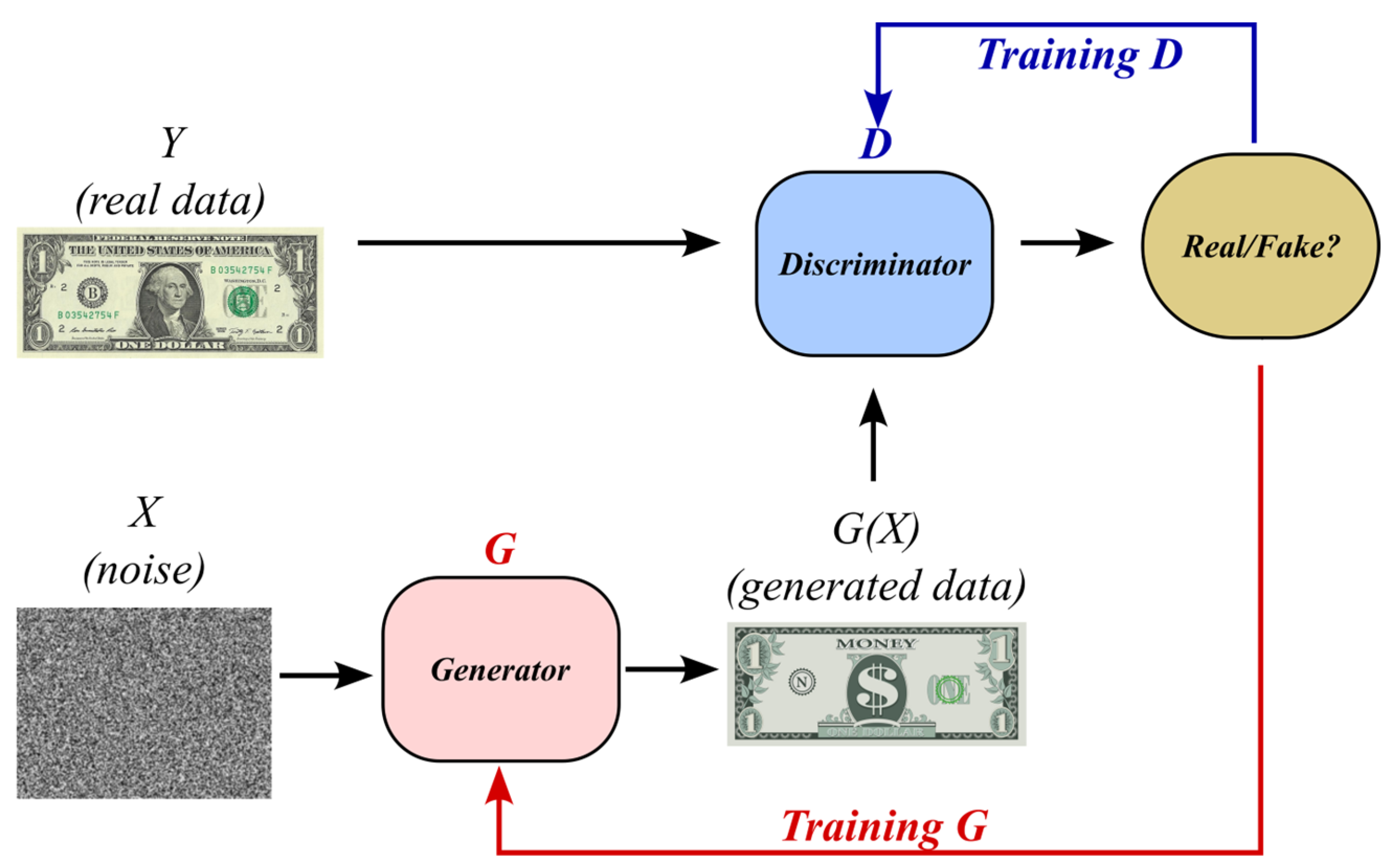
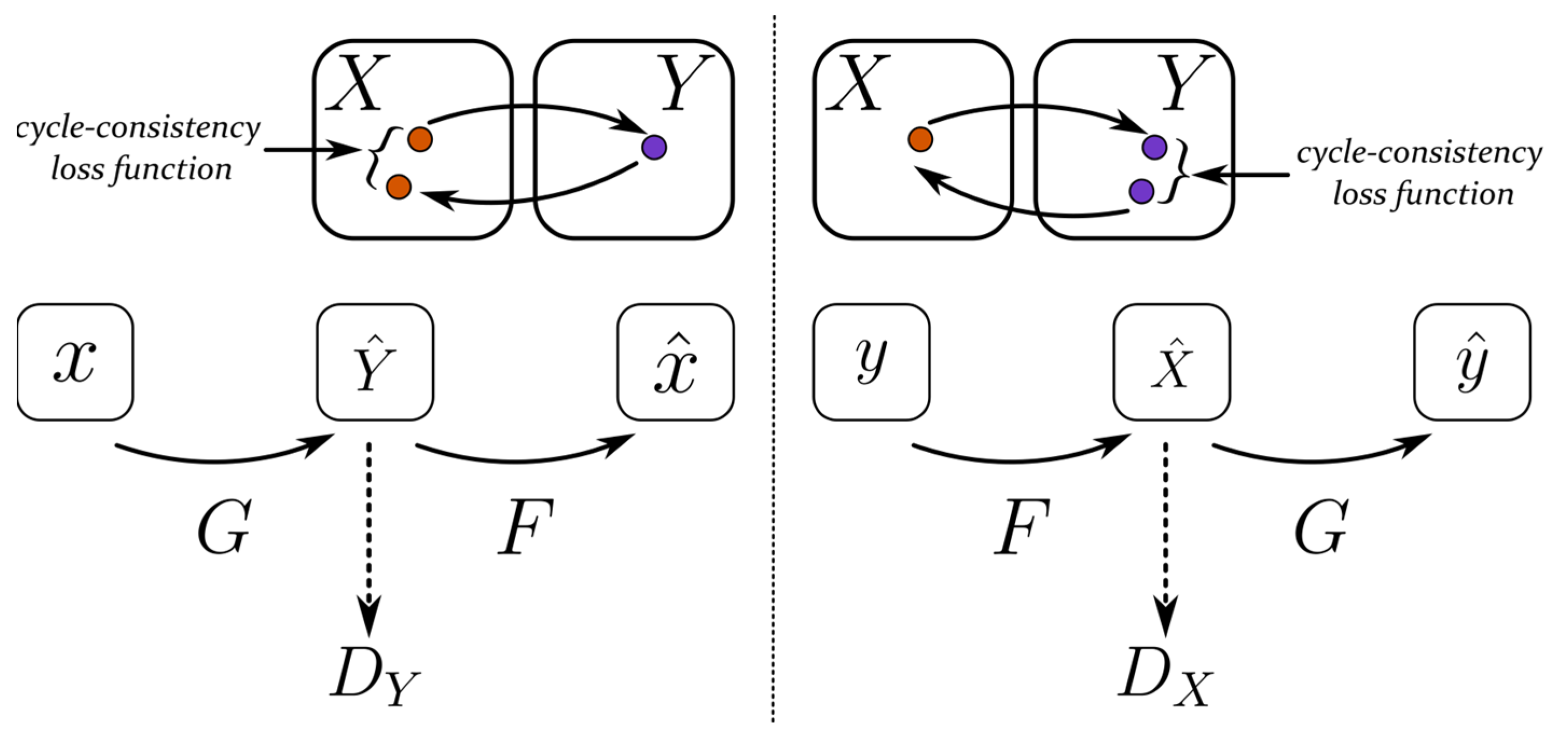
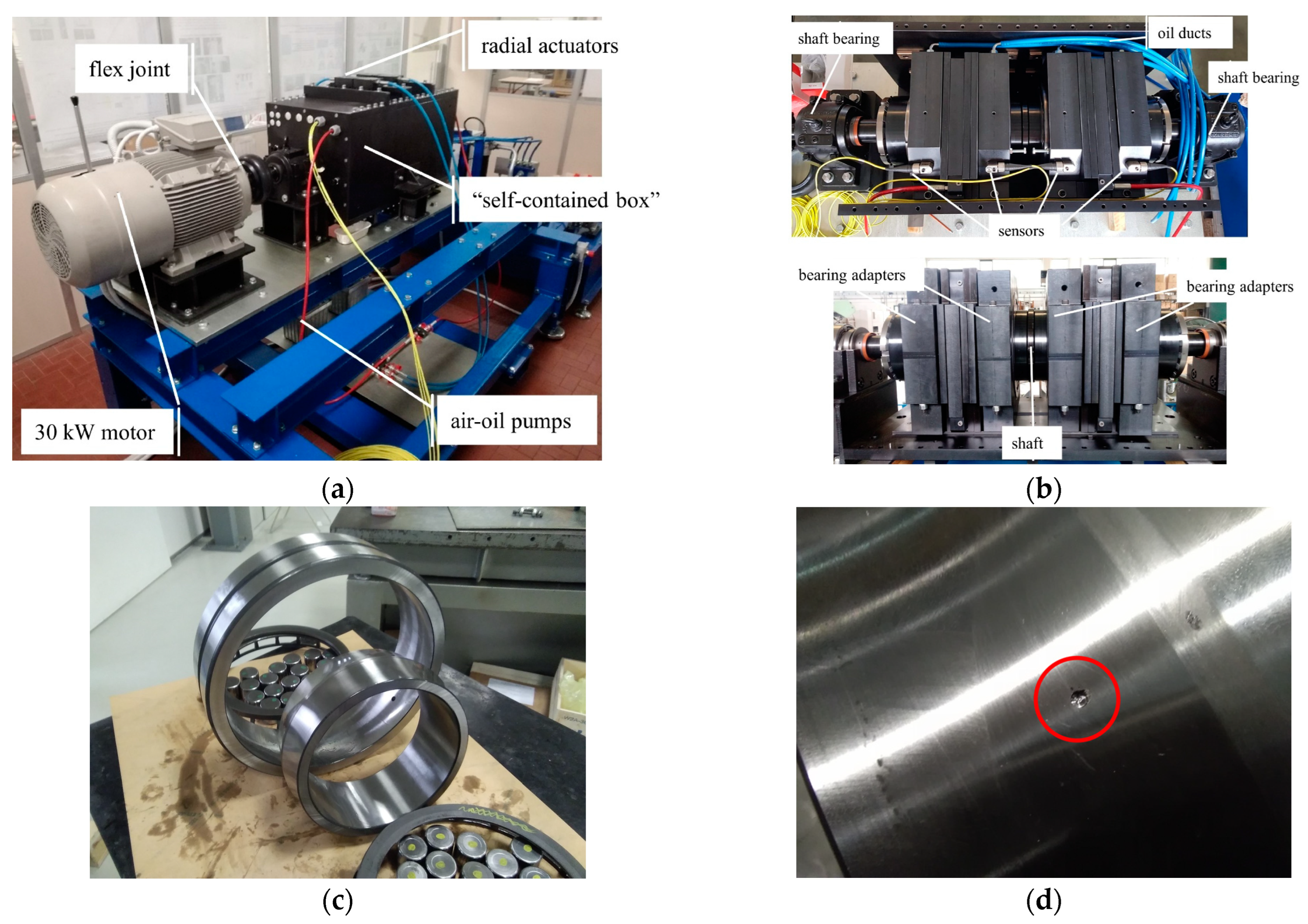
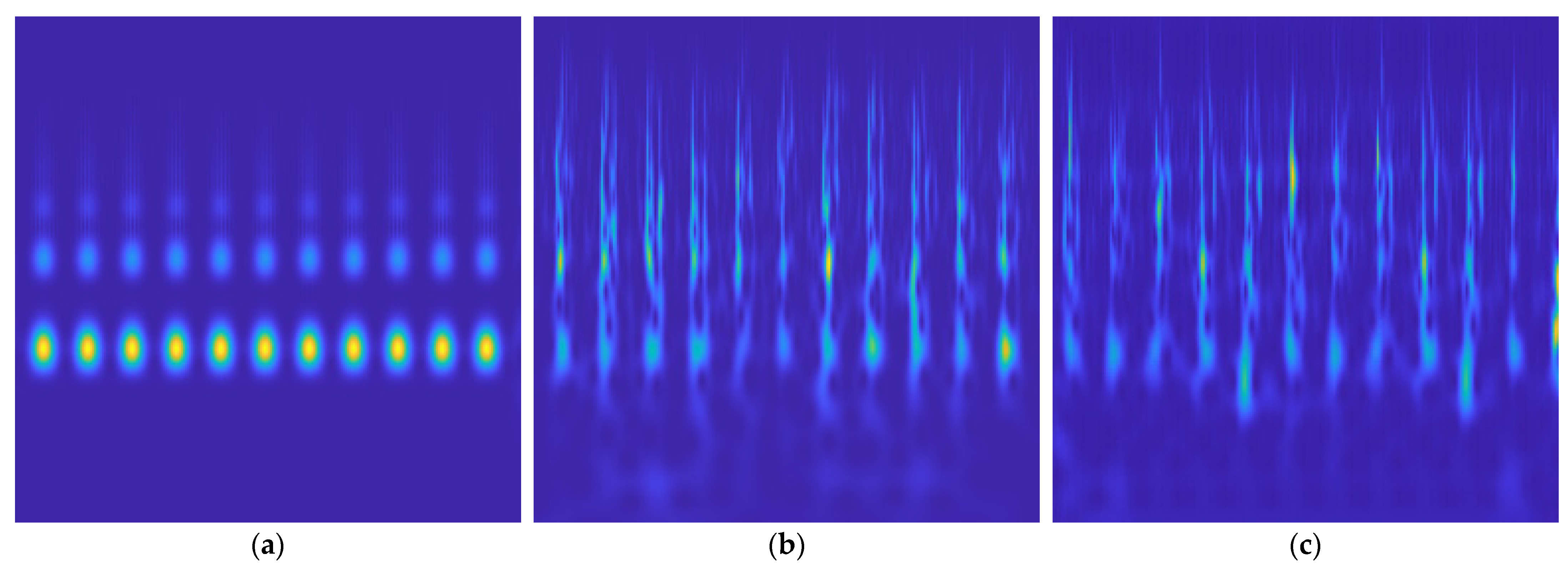
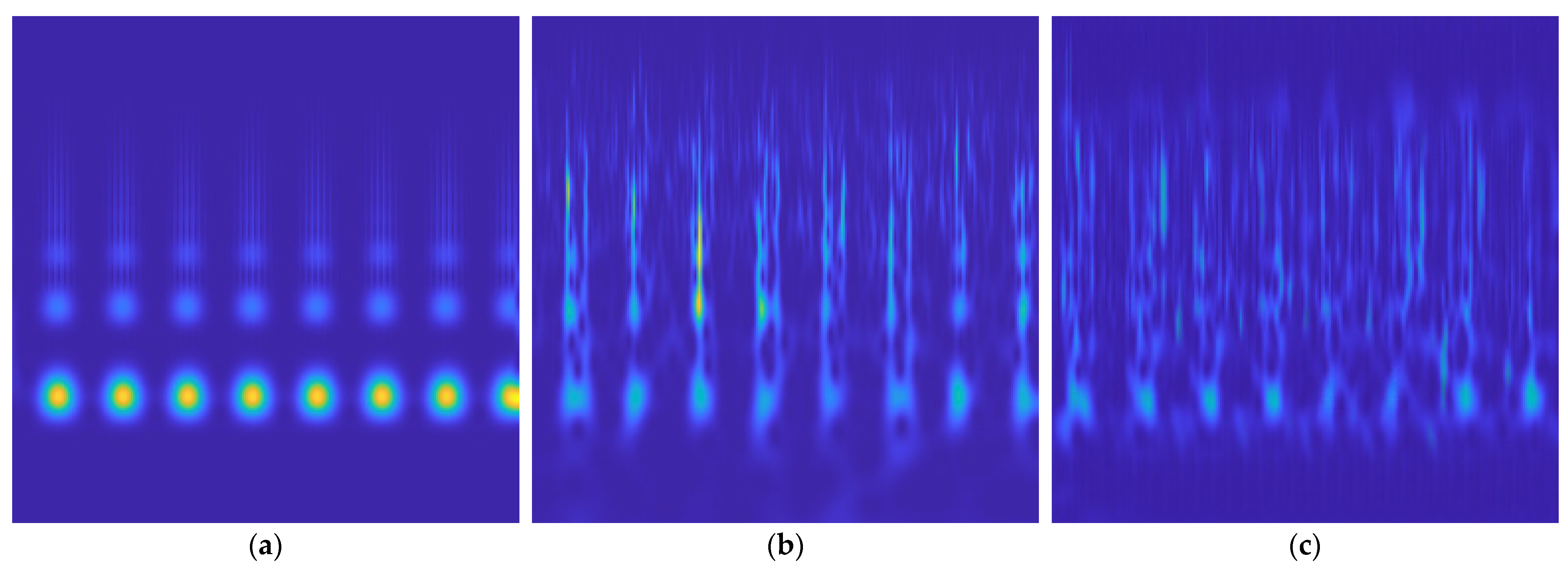

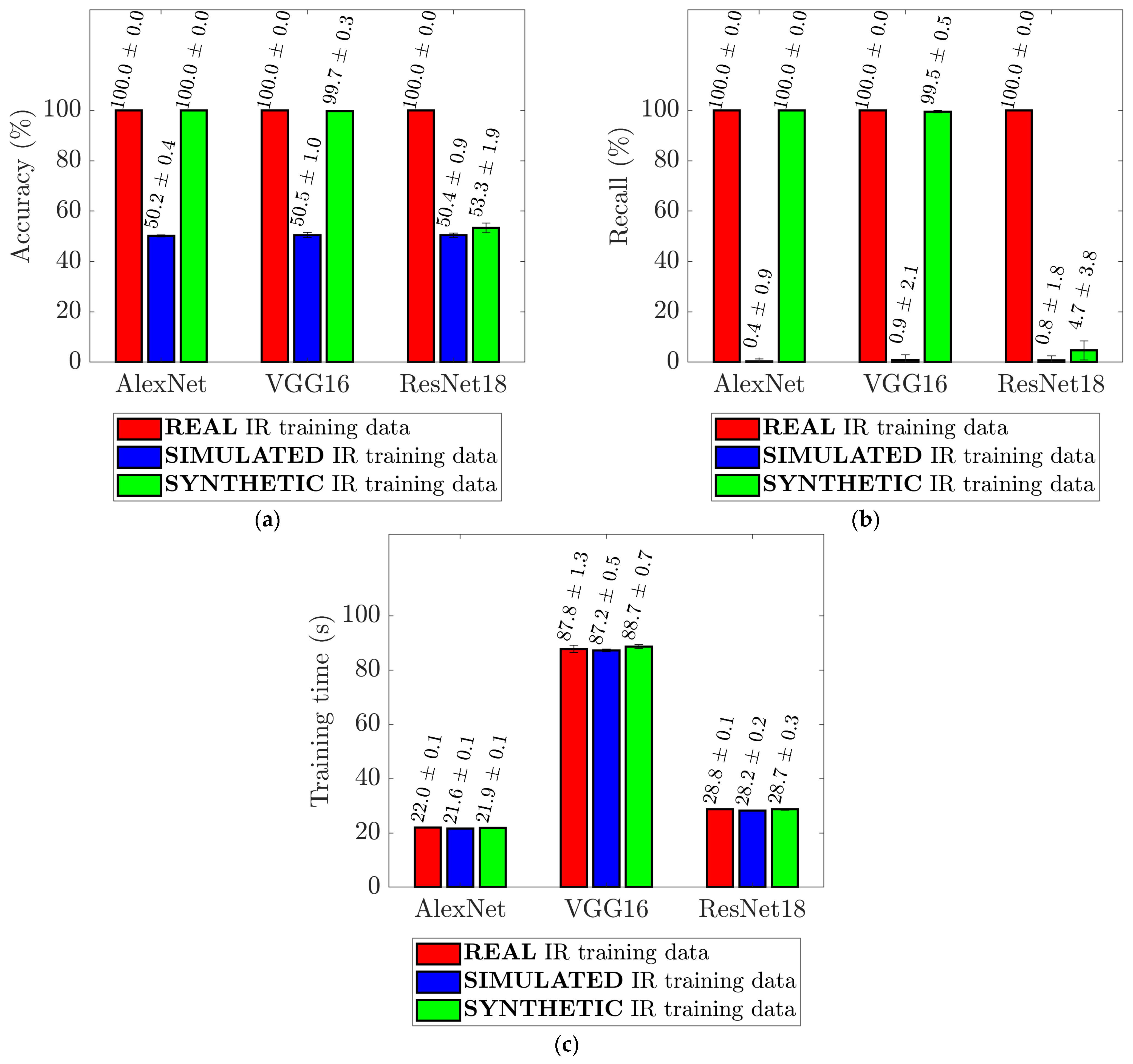
| Radial load (kN) | 124.8 |
| Speed (rpm) | 607, 877, 997 |
| Duration (s) | 30 |
| Sampling frequency (Hz) | 20,480 |
| Overlap | 0.7 |
| Chunk duration (s) | 0.8 |
| Chunks per signal | 250 |
| Epochs | 200 |
| Mini-batch size | 1 |
| Optimizer | Adam |
| Learning rate | 0.0002 |
| Gradient decay factor | 0.5 |
| Squared gradient decay factor | 0.999 |
| Adversarial loss weight () | 10 |
| Speeds (rpm) | Data Distributions | MMD | FID |
|---|---|---|---|
| 607 | Real—Simulated | 0.187 | 265.717 |
| Real—Generated | 0.106 | 78.270 | |
| 877 | Real—Simulated | 0.218 | 317.714 |
| Real—Generated | 0.069 | 47.888 | |
| 997 | Real—Simulated | 0.202 | 278.152 |
| Real—Generated | 0.073 | 48.607 |
| Epochs | 4 |
| Mini-batch size | 32 |
| Optimizer | Momentum |
| Initial learning rate | |
| L2 regularization | |
| Momentum factor | 0.9 |
Disclaimer/Publisher’s Note: The statements, opinions and data contained in all publications are solely those of the individual author(s) and contributor(s) and not of MDPI and/or the editor(s). MDPI and/or the editor(s) disclaim responsibility for any injury to people or property resulting from any ideas, methods, instructions or products referred to in the content. |
© 2023 by the authors. Licensee MDPI, Basel, Switzerland. This article is an open access article distributed under the terms and conditions of the Creative Commons Attribution (CC BY) license (https://creativecommons.org/licenses/by/4.0/).
Share and Cite
Di Maggio, L.G.; Brusa, E.; Delprete, C. Zero-Shot Generative AI for Rotating Machinery Fault Diagnosis: Synthesizing Highly Realistic Training Data via Cycle-Consistent Adversarial Networks. Appl. Sci. 2023, 13, 12458. https://doi.org/10.3390/app132212458
Di Maggio LG, Brusa E, Delprete C. Zero-Shot Generative AI for Rotating Machinery Fault Diagnosis: Synthesizing Highly Realistic Training Data via Cycle-Consistent Adversarial Networks. Applied Sciences. 2023; 13(22):12458. https://doi.org/10.3390/app132212458
Chicago/Turabian StyleDi Maggio, Luigi Gianpio, Eugenio Brusa, and Cristiana Delprete. 2023. "Zero-Shot Generative AI for Rotating Machinery Fault Diagnosis: Synthesizing Highly Realistic Training Data via Cycle-Consistent Adversarial Networks" Applied Sciences 13, no. 22: 12458. https://doi.org/10.3390/app132212458
APA StyleDi Maggio, L. G., Brusa, E., & Delprete, C. (2023). Zero-Shot Generative AI for Rotating Machinery Fault Diagnosis: Synthesizing Highly Realistic Training Data via Cycle-Consistent Adversarial Networks. Applied Sciences, 13(22), 12458. https://doi.org/10.3390/app132212458








